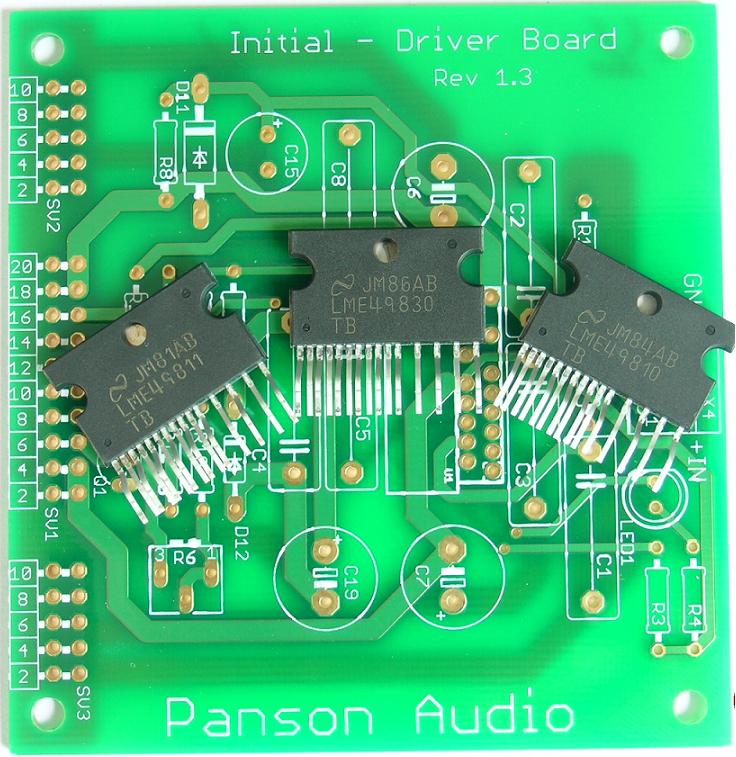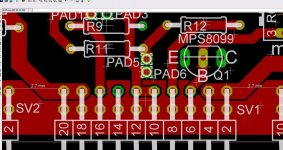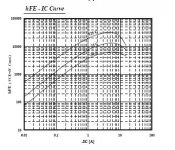Great stuff, Panson!
I'm really looking forward to your comparison of the 3 LME chips, w/wo drivers etc. Will you also compare 49830 w FET's`?
The amatueristic comparisons I did during the last 6 months tells me only what I think about my own amateuristic designs using LME 49810/49830. It will be really interesting to see your scientific approach and measurement results!
Good job!
I'm really looking forward to your comparison of the 3 LME chips, w/wo drivers etc. Will you also compare 49830 w FET's`?
The amatueristic comparisons I did during the last 6 months tells me only what I think about my own amateuristic designs using LME 49810/49830. It will be really interesting to see your scientific approach and measurement results!
Good job!
Segran said:Will you also compare 49830 w FET's`?
Hi Segran,
Yes, I have some IRF240/P9240. Hope they are not fake! Did you find any differences between 49830 and 49810?
I must say I too would like to see the results !
Also if you could post the pin out, spacing of the connectors and voltage limits I might want to buy a "driver board" but design the front-end myself. I was also currently working on a "plugin" amp but this would speed things up.
Cheers !
Also if you could post the pin out, spacing of the connectors and voltage limits I might want to buy a "driver board" but design the front-end myself. I was also currently working on a "plugin" amp but this would speed things up.
Cheers !
Panson wrote
:
I don't have the instruments needed to measure distortion low enough to tell the difference between 49830 and 49810.
Both amps turned out pretty good, THD+N below 0,002%. I found a "sonic" difference that I blame on a higher level of odd harmonics in the 49810+BJT amp that makes me prefer the 49830+IRFP amp. It kind of sounds "sweeter", most noticeable when playing music with brass instruments or piano or acoustic guitar. Even human voices sounds often better. The best way I can describe it is that the sound is less tiring to me ears (and the other people who have compared the two).
But again, that may all be due to shortcomings in my overall designs!
:
Did you find any differences between 49830 and 49810?
I don't have the instruments needed to measure distortion low enough to tell the difference between 49830 and 49810.
Both amps turned out pretty good, THD+N below 0,002%. I found a "sonic" difference that I blame on a higher level of odd harmonics in the 49810+BJT amp that makes me prefer the 49830+IRFP amp. It kind of sounds "sweeter", most noticeable when playing music with brass instruments or piano or acoustic guitar. Even human voices sounds often better. The best way I can describe it is that the sound is less tiring to me ears (and the other people who have compared the two).
But again, that may all be due to shortcomings in my overall designs!
Yoshy said:
Also if you could post the pin out, spacing of the connectors and voltage limits
I use standard 2.54 mm pin headers (two 2 x 5 and one 2 x 10). The image shows you center point space. Is it okay? The board can actually be used for any voltage within LME498xx limit.
Attachments
Yoshy said:... the pin out ...
I can e-mail you the schematic for pin out.
panson_hk said:
I can e-mail you the schematic for pin out.
Yes, that would be nice, I'm still trying to decide if I get the ThermalTraks or regular BJTs (or MOSFETs). I'll wait on your conclusions but I'll be in for 6 boards
There are indeed some differences, the LME49830 is doing a little bit better, but I think it isn't shocking at all.
Do you test to two on the same PCB or two different PCB's? Otherwise it is very likely that there are some tolerances. Keep in mind that there are also always tolerances in the production of chips.
I had some difference in a few other chips that I was testing a time ago.
Nevertheless, great performers
Do you test to two on the same PCB or two different PCB's? Otherwise it is very likely that there are some tolerances. Keep in mind that there are also always tolerances in the production of chips.
I had some difference in a few other chips that I was testing a time ago.
Nevertheless, great performers
b_force said:Do you test to two on the same PCB or two different PCB's?
I used one PCB to test the chips.
LME49811 THD vs output level for different gain sets and R1/2 values.
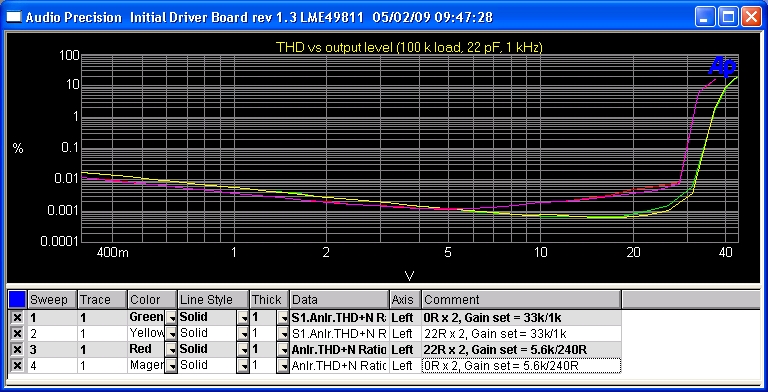
LME49811 data sheet shows that the chip has a much lower driving capability compared to 49810/49830. When the gain set resistors are 5.6k and 240 Ohm, their loading effect (THD increased) can be clearly seen from the curves.
Results for THD versus output load is shown below.
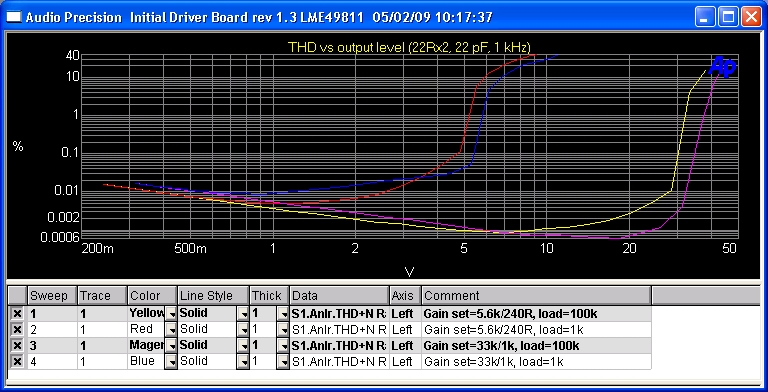
At about 1 mA output load current, THD is going to increase. The results telling us that driver for output stage is a must for 49811. In fact, driver is also necessary for 49810/30 for BJT output stage. Previous result shows that their performance degrade when load current is > about 2.8/8.4 mA.
It seems to me that 49811 is a 49810 with output buffer omitted. The omission might be a factor for better THD performance than 49810. However, it may not contribute to the overall amplifier's THD performance. We probably need to add a pre-driver to 49811, i.e. pre-driver, driver and output stage. The pre-drivier is indeed the 49810's buffer.
Simple calculation:
NJL3281 output BJT current gain 75 for Ic = 5 A (@100W, 8 Ohm)
base current of 3281 = 66 mA
MJE15030 driver current gain 40
base current of 15030 1.7 mA
Case 1, LME49810/30 can provide 1.7 mA with no degradation.
Case 2, LME49811 with 1.7 mA load will degrade. We need to add a pre-driver.
LME49811 data sheet shows that the chip has a much lower driving capability compared to 49810/49830. When the gain set resistors are 5.6k and 240 Ohm, their loading effect (THD increased) can be clearly seen from the curves.
Results for THD versus output load is shown below.
At about 1 mA output load current, THD is going to increase. The results telling us that driver for output stage is a must for 49811. In fact, driver is also necessary for 49810/30 for BJT output stage. Previous result shows that their performance degrade when load current is > about 2.8/8.4 mA.
It seems to me that 49811 is a 49810 with output buffer omitted. The omission might be a factor for better THD performance than 49810. However, it may not contribute to the overall amplifier's THD performance. We probably need to add a pre-driver to 49811, i.e. pre-driver, driver and output stage. The pre-drivier is indeed the 49810's buffer.
Simple calculation:
NJL3281 output BJT current gain 75 for Ic = 5 A (@100W, 8 Ohm)
base current of 3281 = 66 mA
MJE15030 driver current gain 40
base current of 15030 1.7 mA
Case 1, LME49810/30 can provide 1.7 mA with no degradation.
Case 2, LME49811 with 1.7 mA load will degrade. We need to add a pre-driver.
5Apk is a completely unreasonable maximum current for a 100W amplifier driving an 8ohm speaker.
That 5Apk applies to a purely resistive load only.
I suggest you look at 15Apk as a transient peak current that will satisfy the demands of most 8ohm speakers when driven by an amplifier with a maximum output ~40Vpk.
6ohm, 4 to 8ohm and 4ohm speaker can demand even higher transient peak currents.
The 100W into 8ohm figures using a 2pair output stage become
15Apk split 7.5Apk from each ONsemi requires ~150mApk each (hFE>=50).
Total driver current ~300mApk requires ~1.5mApk (hFE>=100 for MJE15034/5).
Similar answer but requires the output stage to be changed!
Loads below 8ohm impedance require a pre-driver stage and possibly more output devices.
That 5Apk applies to a purely resistive load only.
I suggest you look at 15Apk as a transient peak current that will satisfy the demands of most 8ohm speakers when driven by an amplifier with a maximum output ~40Vpk.
6ohm, 4 to 8ohm and 4ohm speaker can demand even higher transient peak currents.
The 100W into 8ohm figures using a 2pair output stage become
15Apk split 7.5Apk from each ONsemi requires ~150mApk each (hFE>=50).
Total driver current ~300mApk requires ~1.5mApk (hFE>=100 for MJE15034/5).
Similar answer but requires the output stage to be changed!
Loads below 8ohm impedance require a pre-driver stage and possibly more output devices.
Dear All,
Interesting,
I wouldn't go without driver transistor with any BJT because the current gain of BJT's is to low.
But if you use Darlingtons with a hFE of 5000 (like the Sanken STD03's) you can use multiple pairs without adding a driver and still keep maintain low THD. This if you want to keep simplicity.
With best regards,
Bas
Interesting,
I wouldn't go without driver transistor with any BJT because the current gain of BJT's is to low.
But if you use Darlingtons with a hFE of 5000 (like the Sanken STD03's) you can use multiple pairs without adding a driver and still keep maintain low THD. This if you want to keep simplicity.
With best regards,
Bas
A darlington is an integrated driver and output device.
Now go and look at the gain when the output current is around 7.5Apk.
I doubt most manufacturers will even reveal how bad it gets.
Then there are the other downsides to using an integrated driver and output device.
It now becomes a question of whether a pre-driver can recover sufficient performance to make up for all the other disadvantages of using darlingtons.
I reckon that the only reason for inventing the darlington was to save assembly costs on the production line.
Now go and look at the gain when the output current is around 7.5Apk.
I doubt most manufacturers will even reveal how bad it gets.
Then there are the other downsides to using an integrated driver and output device.
It now becomes a question of whether a pre-driver can recover sufficient performance to make up for all the other disadvantages of using darlingtons.
I reckon that the only reason for inventing the darlington was to save assembly costs on the production line.
This driver/output devices configuration is pretty happy with low Z loads. 
An externally hosted image should be here but it was not working when we last tested it.
AndrewT said:A darlington is an integrated driver and output device.
Now go and look at the gain when the output current is around 7.5Apk.
I doubt most manufacturers will even reveal how bad it gets.
Then there are the other downsides to using an integrated driver and output device.
It now becomes a question of whether a pre-driver can recover sufficient performance to make up for all the other disadvantages of using darlingtons.
I reckon that the only reason for inventing the darlington was to save assembly costs on the production line.
Dear Andrew,
I am very aware of the very bad reputation of Darlington designs. I remember Rod Eliot also hates them as he point out on his website.
Sure a Darlington is in fact a BJT with integrated driver but it saves PCB space and tracks, that was my point with "simplicity"
For the rest I can only say to all those Darlington haters, put your pre judges away and give it a listen.
Those Sankens got used in almost every Musical Fidelity amplifier in the nu-vista line. All Arcam amplifiers use them and along them many others. They all got excellent reviews and really sound good.
I was hesitating to design with Darlingtons, but the STD03 seems to be a huge surprise and sound really really good.
With best regards,
Bas
panson_hk said:The Sanken STD03 current gain vs Ic looks very promising. I believe how we use them is most important. However, having the output device modulates the driver temperature is
Thanks you Panson, I tried to upload the same image but it failed.. the hFE curve isn't bad at all, and I think people should put aside their pre judgements for Darlingtons and give the STD3's a serious listening.
With best regards,
Bas
- Status
- This old topic is closed. If you want to reopen this topic, contact a moderator using the "Report Post" button.
- Home
- Amplifiers
- Chip Amps
- Comparing LME49810, 49830 and 49811
